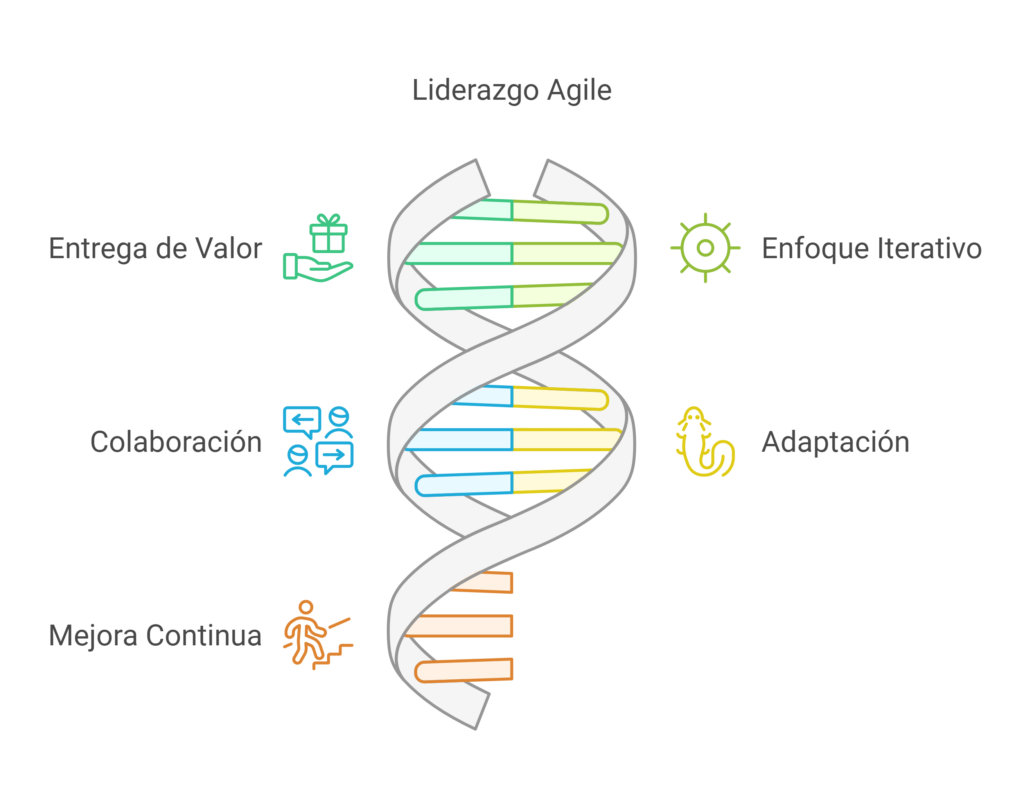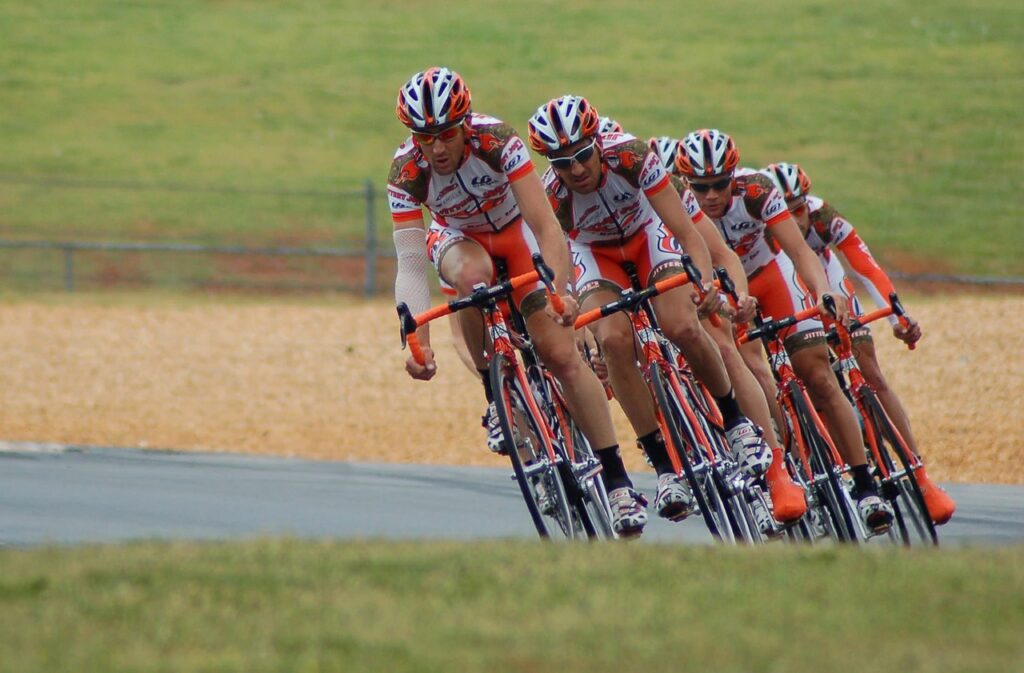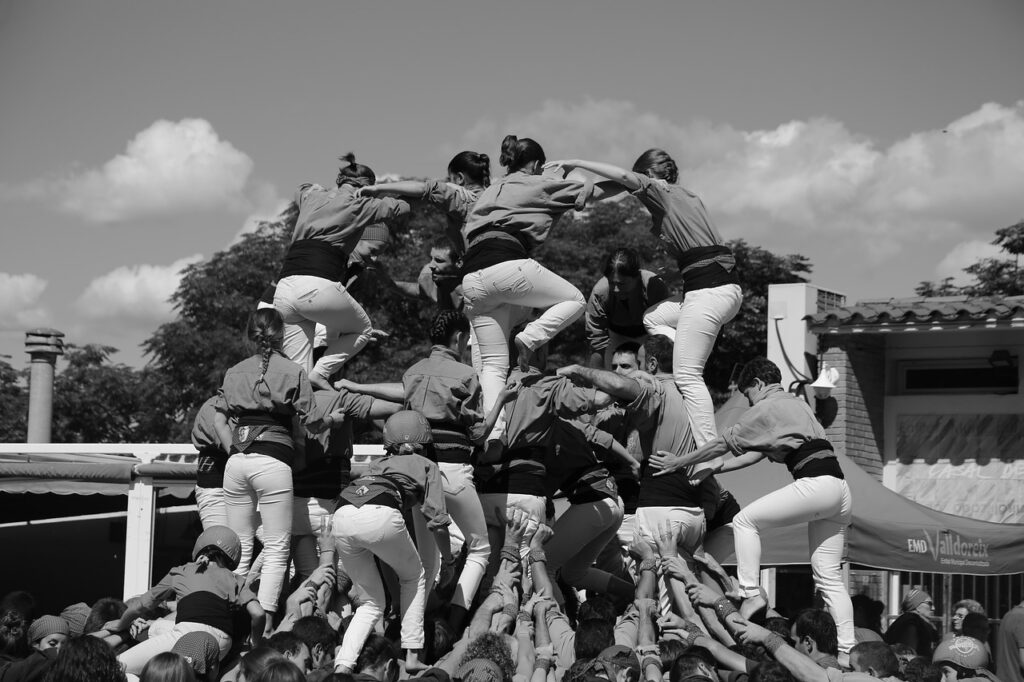
In this article we will explain what is Agile leadership or Agile leadership, or as some authors call it New Forms of Leadership. We will discuss what aspects to consider, how it relates to facilitation and when it would be interesting to receive support for its development. Although it is said at the outset, I do not know if there is a formal definition of it.
Spolier Alert! Being practical, if you want you can save yourself from reading more:
For me, Agile leadership is the ability to mobilize a group of people towards a shared common goal, creating a high performance team.
Easy, isn’t it?
In fact, every leader wants to help our teams become high-performance teams, but… What is a high-performance team?
A high-performance team is a group of people who share common goals and a common vision, and who collaborate, challenge and take responsibility for each other to achieve outstanding results. This, according to the Tuckman model, would be a team in a Performing state, but we will come back to Tuckman later.
Leadership centered on Agile principles
In the Agile Manifesto there is a principle that talks specifically about leadership:
“Projects are developed around motivated individuals. You have to give them the environment and support they need, and entrust them with the execution of the work.
”
That’s it! Easy! We tell them:
“Team empower yourselves!!! Self-organize!”
And we have it done… or not!
If it were that easy… let’s go back to the beginning, to the basics.
If the basis of this leadership is Agile, it seems obvious that it must share certain Agile principles. For me, this Agile leadership style is based on the following pillars:
- Delivering value
- Iterative and incremental approach
- Collaboration
- Adaptation
- Continuous improvement
These principles may be familiar to us when working, managing a product, service or project. But as a team leader?
When I say leader I am not only referring to the manager of a team, I am also referring to a Scrum Master, an Agile Coach, a Technical Lead, a team leader, a manager or any figure (regardless of the name) that has as one of its objectives to help the team to achieve a common goal.

These pillars can be carried over to Agile Leadership:
- Value delivery: the team must know what their purpose is, what impact is expected of them. Not what they are expected to do, but what they do that is expected to help the organization. They must understand what their value contribution is.
- Iterative and incremental approach: As an Agile leader you must help your team to integrate these concepts: iterative and incremental.
- Iterative: we don’t try to do everything perfect the first time, but we try to get it right and improve with feedback.
- Incremental: we do not seek to make it completely complete the first time, but we work on it according to priorities.
- These concepts taken to Agile leadership, we have to master them. For me, this is very much related to change management. As an Agile manager, we must help the team deal with the changing environment. Changes introduced suddenly, breaking dynamics and relationships that work can have dire consequences, mastering the art of change management using tools like ADKAR or simply understanding that there are circumstances where changes have to be “a few at a time” will allow you as an Agile leader to help your team a lot.
- Collaboration: As an Agile leader you have to understand that team members can reach their goals as individuals but will get further if they go as a team. Knowing tools that help improve the relationship between team members, and the relationship with the teams they work with is fundamental to achieve the organization’s goals.

- Adaptation: from an Agile leader’s point of view, this pillar is related to “iterative and incremental”, especially in the change management part. If we want to help our teams in the ability to adapt to change, we must be the first to show this ability to adapt. And this is not about “saying yes to everything”, but about using critical thinking to make decisions about the positives of the changes that require our adaptation.
- Continuous improvement: A good Agile leader must be a promoter of team improvement. But not to improve once, one day, one time… but to establish mechanisms that allow the team to reflect and plan actions that help them to improve their objectives or the way they achieve them. It is not a question of doing retrospectives every 15 days, although some teams may do so, but of making the thought of improvement part of the team’s day-to-day work, in everything they do.
When you need Agile leadership consulting
It is really ALWAYS, at any time, a good time to know how the equipment is performing.
As a leader you want to know how your team functions, the degree of maturity they have as a team and above all what dysfunctions they have in order to help them better.
Knowing the state of the team is essential to being a good Agile leader. What we want as leaders is to maximize our actions. Understanding the state of a team will help us know what actions we can take to generate positive impact on the team.
Taking actions without knowing the status of the equipment is like launching paper airplanes and expecting them to reach the clouds.

At Smart Way, we have developed the “Team Maturity Advisor” which is a leadership agent based on psychological tests, Data Analysis and Artificial Intelligence, which allows you to know the state of the team, proposes key actions and allows you to follow up on the impact of the actions. It is the tool that every leader wants to have if he/she wants to be a good Agile leader.
Agile team leadership
Leadership in Agile teams, we could say, is embodied by the role of the Scrum master. Although this has a certain “trap”, let’s see it.
The first thing is that we must understand that Scrum Master is a role, which means that it will not always be a person.
In teams that are not yet high performing, it will be necessary to have a Scrum master, either full time or performing this role in several teams.
As the team matures, the functions of the Agile team leader role are acquired by the other team members until, in the end, this role is executed by the entire team.
The functions of the Scrum Master’s role, we could explain as “is responsible for the team to use Scrum to maximize the value they bring based on the principles of transparency, inspection and adaptation. And supported by the values of Commitment, Courage, Respect, Openness and Focus.
The Scrum Master is not a post-it manager, but is the person who makes sure that Scrum events, artifacts and roles actually serve their purpose and serve the team.
Agile leadership and facilitators
There is a general belief that an Agile Leader is a facilitator, and that is not always true. The way the leader role is executed is going to depend TOTALLY on the maturity level of the team they are leading. A newly formed team does not need a facilitator, it needs someone more directive to explain to the team, order them and guide them.

To learn more about the role of the leader in the different levels of team maturity, read on in the Tuckman model chapter.
Essential tools to master
If you want to improve as a leader, it is clear that knowing the team is fundamental, knowing at what level of maturity it is or what dysfunctions it presents.
For this, there are two essential “tools”, seriously, they are the ones that will allow you to maximize the impact of your Agile leadership actions.
Tuckman Model
Scientist Bruce Tuckman developed a team maturity model in the late 1960s that is still fully applicable today.
His model describes 4 phases of team maturity, where the leader’s role in each phase should vary to help the team reach its maximum maturity level in the shortest possible time. Watch out! That this is like cooking, there are things that require time. Even if you have a thermomix, the sauce has to be stirred for 10 minutes.
As a leader, bringing your team to peak performance would be a process that would surely happen naturally but it is not that trivial or that simple and obviously millions of teams never reach this state because their leaders do not know this “tool”.
To be a good Agile leader you have to:
- to know how to lead each of the phases in order to reach the last one, performing, as quickly as possible.
- Each phase requires different leadership and guidelines.
- These phases need not be sequential. But they all exist…
Tuckman model stages
If you want to be a good leader you must be able to identify the maturity stage of the team.
To be a good Agile leader, this brief guide can help you detect signs of the maturity stage of your team.
Forming
In the forming state the equipment can act as follows:
- Initial comfort and mutual acceptance: Members avoid conflict, remain in their comfort zone and seek acceptance.
- Active search for information and guidance: Members ask questions to understand roles, objectives and expectations.
- Lack of common agreements: It is difficult to align perspectives and priorities within the team.
- Unclear distribution of responsibilities: There is no clarity about who does what, generating confusion and dependence on the leader.
- Lack of established processes: The team has no clear rules or routines to coordinate its work.
- Lack of information flow: Communication is limited and is often one-way, from the leader to the team.
- Poorly defined objectives: Objectives are vague or too general, making alignment difficult.
- Little effective communication: Exchanges are superficial, avoiding sincere opinions for fear of conflict.
- Dominance of a few members: Some assume a predominant role while others remain passive.

Storming (Confrontation)
How the equipment acts when it is in Storming state:
- Competing team ideas: Debates and disagreements arise over the best solutions or approaches.
- Unresolved problems remain: Conflicts persist that are not adequately addressed, generating tensions.
- Some members focus on details and avoid real issues: There is a tendency to avoid major problems by focusing on minor issues.
- We step out of the comfort zone and conflict begins: Disagreements are more evident, and the team faces open tensions.
- Low motivation: Frustration over lack of progress can demotivate some members.
- The maturity of the team will determine how quickly we get out of this phase: More mature teams get through this stage more quickly by managing conflict better.
- Underperforming but constructive if well managed: Although the team is less productive, this stage can be key to its development if tensions are well managed.
- Some members try to position themselves strongly: Power struggles and competition for influence within the team are observed.
- Uncertainty persists: The team remains unclear about objectives, roles or directions.
- Unclear roles: There is still no clear definition of responsibilities, which generates friction.
- Internal conflicts over focus, control and direction: Disagreements over how to proceed and who should lead complicate collaboration.
- Chaotic communication: Exchanges are disorderly and ineffective, intensifying conflicts.
Norming (Standardization)
At this stage of maturity, the team usually has some of these behaviors:
- Everyone has a shared goal and a shared plan: The team is aligned around a clear, common goal.
- Ideas have been agreed upon in the team: Proposals have been discussed and agreed upon by all.
- Everyone has the ambition to strive for the team objective: There is a collective commitment to achieving the objectives.
- Generalized consensus: Decisions are made with the support of the majority, avoiding major conflicts.
- Clear and accepted roles and responsibilities: Each member knows what is expected of him/her and assumes it with confidence.
- Clear decision-making process: Decisions are made in a structured and transparent manner.
- Delegation of responsibilities: Tasks are distributed effectively, encouraging individual autonomy.
- The team enjoys: Teamwork is experienced with enthusiasm and satisfaction.
- The team discusses: Discussions are open and constructive, always seeking solutions.
- Sense of Momentum: There is a feeling of continuous advancement and tangible achievements.
- Relationships are built: Members develop stronger personal and professional bonds.
- Interdependencies are generated: The team works collaboratively, relying on each other’s skills.

Performing
How does the team that is in the maturity stage of performing:
Important: This stage will not always be reached: Only some teams make it to the high performance level!
- High performance is achieved without conflict and without supervision: The team works efficiently and autonomously with minimal intervention.
- Motivated and knowledgeable: Members are committed and trained to fulfill their roles.
- They are competent and highly autonomous: Each member contributes value independently and efficiently.
- Different points of view are accepted, channeled within the team and easily resolved: Diversity of opinions enriches solutions without generating conflict.
- High participation: All members actively contribute to the work and decisions.
- Quick and accurate decisions, based on accepted criteria: The team makes effective decisions based on previous agreements.
- The whole team knows what they are doing and why they are doing it: There is total clarity about the tasks and their purpose.
- Fully shared vision: Everyone shares an understanding of and commitment to the team’s objectives.
- Good relations, fluid communication: There is trust, respect and a constant exchange of information.
- All high-performing teams fall back to other phases (e.g. storming when there is a change of leader): Team dynamics are cyclical and adaptive to significant changes.
- Internalized roles: Each member fulfills his or her role naturally and effectively.
- Rapid alignment in focus: The equipment quickly adjusts to new circumstances or challenges.
- Inter-departmental communication: Collaboration with other teams or areas of the organization is facilitated.
Dysfunctions of Lencioni
“If you could get everyone in the organization rowing in the same direction, you could dominate any industry, in any market, with any competition, at any time.”
Patrick Lencioni
Patrick Lencioni is a renowned author, consultant and organizational management expert, widely known for his focus on team dynamics and leadership. In his influential book “The Five Dysfunctions of a Team,” Lencioni presents a practical and deeply insightful model of the major barriers teams face in reaching their full potential.
This model is fundamental to be understood by the Agile leader and organizations around the world as a key tool to diagnose and overcome the obstacles that limit the cohesion and performance of teams, promoting a culture of trust, accountability and focus on shared goals.
According to Lencioni, the five fundamental dysfunctions are: lack of trust, fear of conflict, lack of commitment, avoidance of responsibility and lack of focus on results.

If you want to promote Agile leadership in your team it is necessary to be able to diagnose what dysfunction your team suffers from using Lencioni’s official test.
Here you can find the 15 affirmations:
Lack of trust:
- Team members openly admit their mistakes and weaknesses.
- Members are willing to ask for help when they need it.
- Conversations are candid and no vulnerabilities are hidden.
Fear of conflict:
- Discussions are approached directly and without avoiding sensitive topics.
- Disagreements in the team are constructive and focused on solving problems.
- Members are not afraid to express their opinions, even if they are unpopular.
Lack of commitment:
- The team makes decisions quickly and unambiguously.
- All members understand and support the decisions made.
- No one leaves the meetings with doubts about what has been agreed.
Evasion of responsibilities:
- Members confront each other when they see poor performance.
- The team establishes clear standards for evaluating its work.
- They hold each other accountable for the fulfillment of commitments.
Lack of attention to results:
- The team prioritizes collective results over individual interests.
- Shared goals are clearly defined and achievements are celebrated.
- Each member is more focused on the team’s objectives than on his or her own successes.
Summarizing
If you want to improve as a team leader and become an Agile leader, you must master the diagnostic tools to detect the state of maturity of the team, as well as the dysfunctions that the team may present.
This will allow your actions as a leader to be more efficient and, of course, effective!
This is a road of thousands of kilometers and today we have explored some tools to start walking towards the desired destination.




